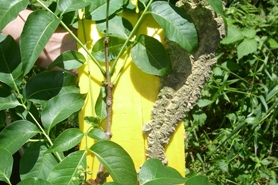Amur cork tree
(Phellodendron amurense)
Distinct tree with thick corky or spongy outer bark, and bright yellow inner bark. Leaves are opposite pinnately compound and faintly smell of citrus when crushed. Trees have strong, rot-resistant wood.
Other names for this plant include:
- Common names: Amur cork tree
- Scientific names: Phellodendron amurense
Classification in Wisconsin: Prohibited *Exempt male cultivars and seedling understock.
- Ecological Threat
-
- Suppresses regeneration of native tree species and displaces native shrub and herbaceous layers.
- Research shows decreases in acorn and hickory nut production as well as overall tree populations where Amur cork tree is present.
- Adaptable to different soil types (clays to sands), acidic to alkaline, but prefers moist, well-drained soils.
- Grows in both full sun and under dense shade.
- Reproduces by both seeds and by resprouting from stumps. A female tree can produce thousands of seeds.
- Allelopathic; chemical exudates alter soil microorganisms and surrounding vegetation.
- Grown throughout the United States; tolerant of urban areas (pollution, parking lots, golf courses, highway medians).
- Identification
-
Leaves & stems: Distinct thick corky or spongy outer bark; cutting into the bark reveals bright yellow inner bark. Opposite pinnately compound leaves smell somewhat of citrus or disinfectant when crushed. Leaflets are entire and dark green, turning yellow in fall. Can resprout from cut-stumps.
Flowers: Both male and female flowers (on separate trees) are greenish panicles.
Fruits & seeds: Trees are dioecious, producing fruit only on female plants. Fruits are drupes (fleshy fruit with a single stone), green in color, turning black in fall. Fruits remain on trees into winter.
- Control
- Mechanical:
- Control should prioritize the removal of female (fruiting) trees first.
- Trees can be controlled by girdling.
- Resprouts vigorously if not treated after cutting.
- Follow up with the replanting of desirable species.
- Treatment can include hack and squirt (frilling), cut stump treatments or basal bark treatments.
- Systemic herbicides include triclopyr and glyphosate.
- Treat with a foliar spray of Transline (1 oz/gal) in mid-summer, pre-bloom to bloom stage.
- All trees larger than 3" can be cut and treated with either Tordon or Element 4. Smaller trees can be treated with foliar applications of Element 4 (3-4%).
- A cut-stump treatment was applied with Crossbow (2, 4-D + triclopyr) with diesel.
- Resources
- Sources for content:
- Elizabeth J. Czarapata. Invasive Plants of the Upper Midwest: An Illustrated Guide to Their Identification and Control. Madison, WI: the University of Wisconsin Press, 2005.
- Plant Conservation Alliance's Alien Plant Working Group
- Center for Invasive Species and Ecosystem Health; Invasive.org



